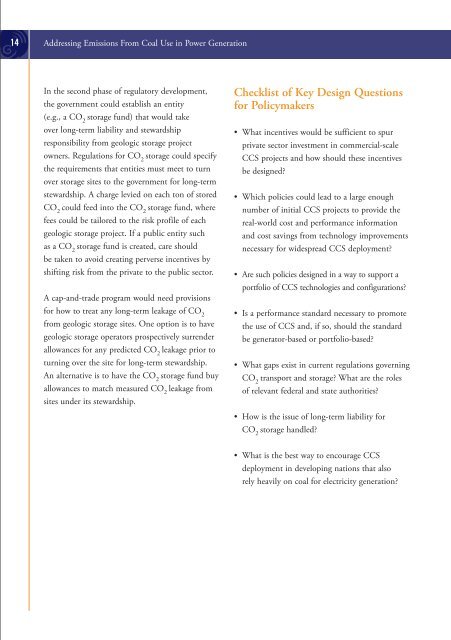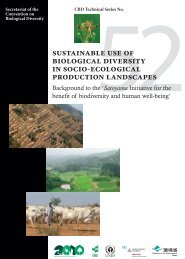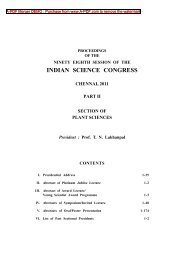Addressing Emissions From Coal Use in Power Generation ...
Addressing Emissions From Coal Use in Power Generation ...
Addressing Emissions From Coal Use in Power Generation ...
You also want an ePaper? Increase the reach of your titles
YUMPU automatically turns print PDFs into web optimized ePapers that Google loves.
14 <strong>Address<strong>in</strong>g</strong> <strong>Emissions</strong> <strong>From</strong> <strong>Coal</strong> <strong>Use</strong> <strong>in</strong> <strong>Power</strong> <strong>Generation</strong><br />
In the second phase of regulatory development,<br />
the government could establish an entity<br />
(e.g., a CO 2<br />
storage fund) that would take<br />
over long-term liability and stewardship<br />
responsibility from geologic storage project<br />
owners. Regulations for CO 2<br />
storage could specify<br />
the requirements that entities must meet to turn<br />
over storage sites to the government for long-term<br />
stewardship. A charge levied on each ton of stored<br />
CO 2<br />
could feed <strong>in</strong>to the CO 2<br />
storage fund, where<br />
fees could be tailored to the risk profile of each<br />
geologic storage project. If a public entity such<br />
as a CO 2<br />
storage fund is created, care should<br />
be taken to avoid creat<strong>in</strong>g perverse <strong>in</strong>centives by<br />
shift<strong>in</strong>g risk from the private to the public sector.<br />
A cap-and-trade program would need provisions<br />
for how to treat any long-term leakage of CO 2<br />
from geologic storage sites. One option is to have<br />
geologic storage operators prospectively surrender<br />
allowances for any predicted CO 2<br />
leakage prior to<br />
turn<strong>in</strong>g over the site for long-term stewardship.<br />
An alternative is to have the CO 2<br />
storage fund buy<br />
allowances to match measured CO 2<br />
leakage from<br />
sites under its stewardship.<br />
Checklist of Key Design Questions<br />
for Policymakers<br />
• What <strong>in</strong>centives would be sufficient to spur<br />
private sector <strong>in</strong>vestment <strong>in</strong> commercial-scale<br />
CCS projects and how should these <strong>in</strong>centives<br />
be designed?<br />
• Which policies could lead to a large enough<br />
number of <strong>in</strong>itial CCS projects to provide the<br />
real-world cost and performance <strong>in</strong>formation<br />
and cost sav<strong>in</strong>gs from technology improvements<br />
necessary for widespread CCS deployment?<br />
• Are such policies designed <strong>in</strong> a way to support a<br />
portfolio of CCS technologies and configurations?<br />
• Is a performance standard necessary to promote<br />
the use of CCS and, if so, should the standard<br />
be generator-based or portfolio-based?<br />
• What gaps exist <strong>in</strong> current regulations govern<strong>in</strong>g<br />
CO 2<br />
transport and storage? What are the roles<br />
of relevant federal and state authorities?<br />
• How is the issue of long-term liability for<br />
CO 2<br />
storage handled?<br />
• What is the best way to encourage CCS<br />
deployment <strong>in</strong> develop<strong>in</strong>g nations that also<br />
rely heavily on coal for electricity generation?

















